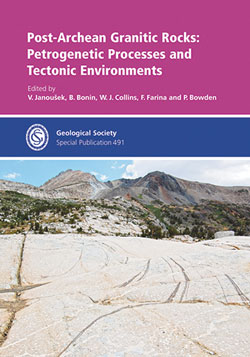Post-Archean Granitic Rocks: Petrogenetic Processes and Tectonic Environments

In ten papers this volume summarises much of frontier thinking about the varied origins and tectonic settings of granites, from the anatexis of metasediments (S-type) to the dual origin I-type granites as either partial melts from lower-crustal igneous rocks or from fractionation of mantle-derived magmas, to the so-called anorogenic (A-type) granites occurring in a variety of tectonic settings.
Granite classification and plotting schemes are reviewed with the serious inherent drawbacks of the commonly-used (even in this volume) Harker plots pointed out, but there is recognition of ‘inertia’ and unwillingness to change from familiar to new, even if more useful, plots. The innovative (for granites) accounts and open access programs of Mayne et al enable the stable mineral phases and their Pressure-Temperature (P-T) stability fields to be calculated for variable P, T, and bulk compositions. This allows the determination of the compositions of melt batches generated by sequential melting of any pelite composition with other variables, such as limited porosity or water in excess. Water is crucial in determining melt and crystallisation temperatures and the vital role of muscovite breakdown in providing water in melting pelites is emphasised. The water-fluxed and dehydration melting origins of granites and trondhjemites of southernmost Italy further emphasises this, as does the different production of magmatic and metasomatic trondhjemites by water-fluxed melting and subsolidus hydrous metasomatic destruction of alkali feldspars in already crystallised granite.
Accounts include the petrogenesis of leucogranites in collisional orogens; S-I-A granites in the Lachlan orogen and A-types in Nigeria; the dual (melt and fractionation) origin of I-types; granites and crustal heat; and laboratory experiments of fluid-fluxed melting, which after fractionation relates to Cordilleran batholiths above subduction zones.
Long-lived episodically constructed plutons formed by sequential magma injections giving zoned granites are well illustrated by the described ‘normally zoned’ mafic tonalitic-edged Sardinian Budduso body. This becomes more felsic inward but the quite common ‘reversely zoned’ bodies, requiring different tectonic conditions of emplacement, are not considered. The important roles of isotopes in identifying melt sources and their ages, as well as the ages of consolidation are not overlooked.
This is strongly recommended as a well-written and colour illustrated volume, replete with significant advances in detailing geochemical modelling of granite magma genesis and crystallisation that others can use. There is lesser tectonic detail. The authors and editors should be congratulated on a volume of wide interest.
Reviewed by Bernard Elgey Leake
POST-ARCHEAN GRANITIC ROCKS: PETROGENETIC PROCESSES AND TECTONIC ENVIRONMENT by V. Janoušek, B. Bonin, W. J. Collins, F. Farina & P. Bowden (editors, 2020). Geological Society of London Special Publication No 491.298 pp. (hbk) ISBN 978-1-78620-448-6. 298 pp.
List Price: £100.00
W: https://www.geolsoc.org.uk/SP491